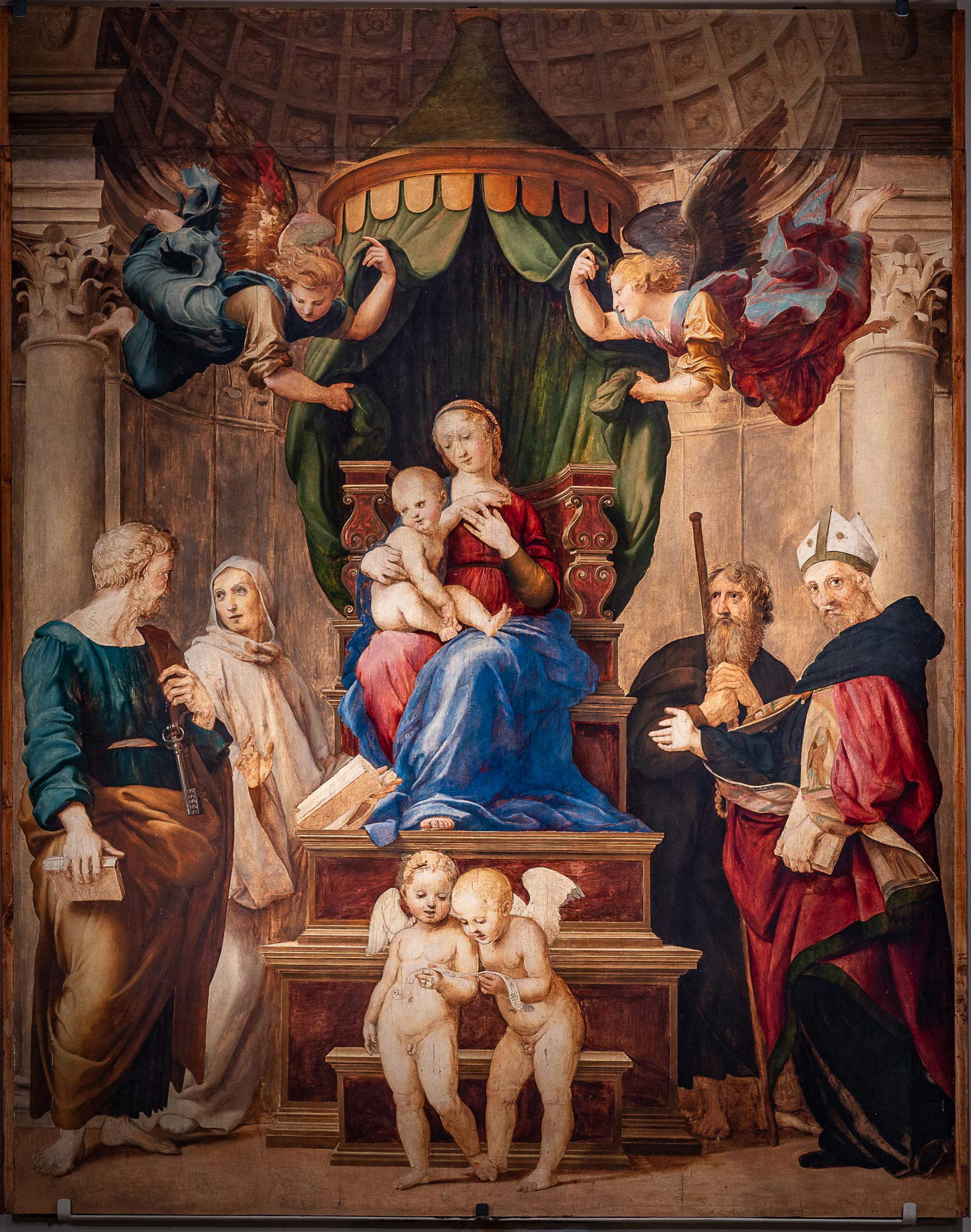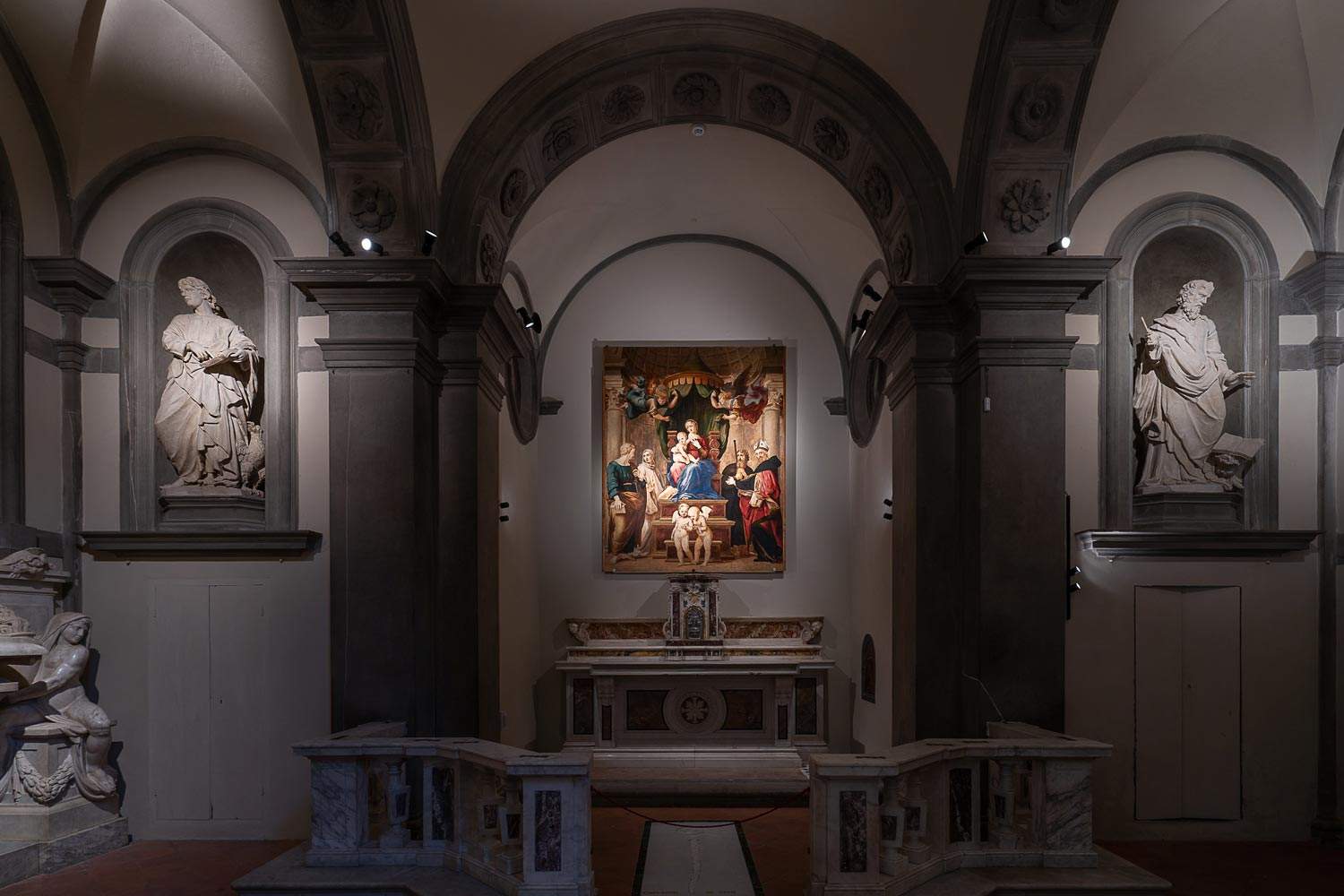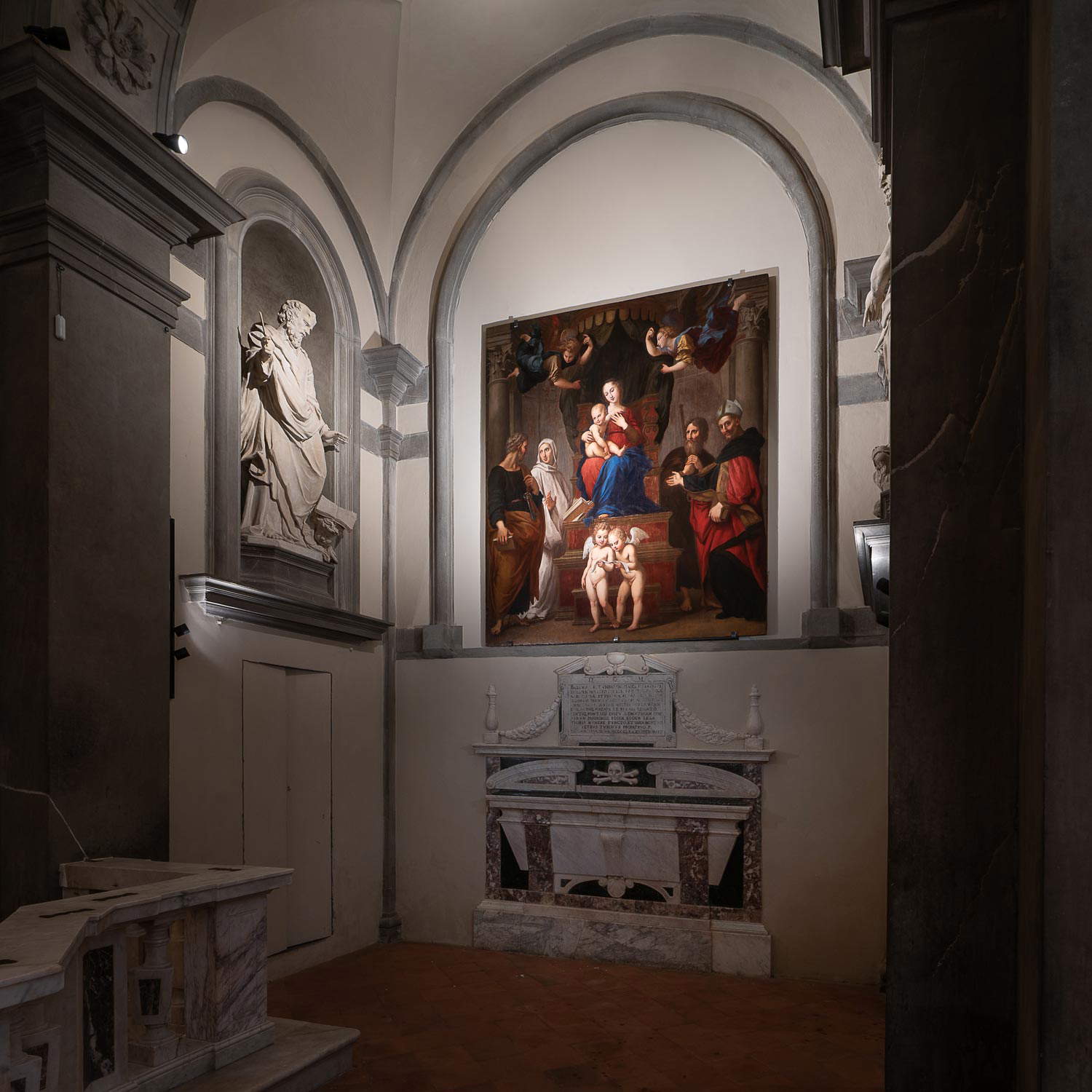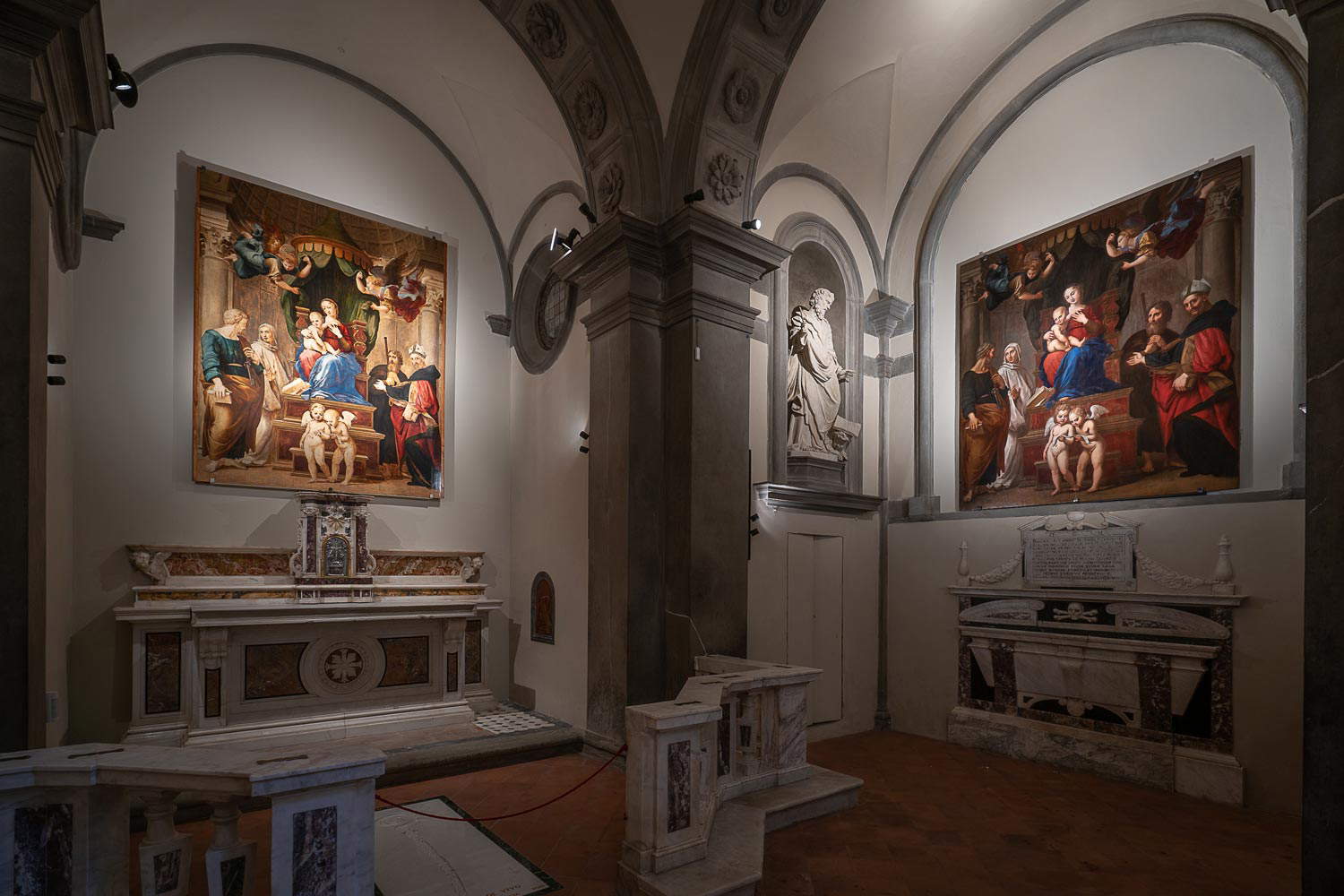The Madonna of the Baldacchino, a great work by Raphael Sanzio (Urbino, 1483 - Rome, 1520) that can be counted among the fundamental works of the mature Renaissance, temporarily leaves the Palatine Gallery of Palazzo Pitti in Florence and returns, from May 7 to July 30, to the Cathedral of Pescia, the church that had welcomed it for more than a century and a half between the 16th and 17th centuries. The work, for the occasion, is compared with the copy commissioned from the Florentine painter Pier Dandini in the late 17th century precisely to replace it when it returned to Florence.
After more than three hundred and twenty years, then, the Madonna del Baldacchino reappears for the first time in Pescia. The event, of historic significance, is the result of a special project put in place as part of the Uffizi Diffusi program; supporting the ambitious operation is the Fondazione Caript. In preparation for its ’transfer,’ the Madonna del Baldacchino underwent a light consolidation intervention in the highest portion of the wooden support and careful diagnostic investigations by theOpificio delle Pietre Dure of Florence that determined its state of health. The specialists’ response determined that the work is fine, and that it can be moved to Pescia and displayed in the cathedral without any problems.
Created by Raphael between 1506 and 1508 on a commission from the Dei family, the large altarpiece was intended for the Church of Santo Spirito in Florence, where, however, it never went. Called to Rome in the fall of 1508 by Pope Julius II, who entrusted him with the decoration of his apartments in the Vatican (now universally known as Raphael’s Rooms), the Urbino in fact left the altarpiece for the Dei unfinished, which therefore never reached the church and was replaced in 1522 by Rosso Fiorentino’s Sacred Conversation, also now on display in the Palatine Gallery in Palazzo Pitti.
Of Raphael’s work came into possession not many years later, his friend and executor Baldassarre Turini (1481-1543), a high prelate of the Holy See in the early 16th century as well as a prominent member of the Pescia community. Arriving in the town of Valdinievole, the painting was placed in the cathedral, on the altar of the Turini’s chapel-mausoleum that Baldassarre himself had had erected between the 1430s and 1440s also to worthily accommodate the Urbino altarpiece. The Madonna del Baldacchino remained there for a century and a half, until 1697: in that year it was purchased by Grand Prince Ferdinando de’ Medici, who brought it back to Florence to the palace of Palazzo Pitti, its current home, where it is displayed among the masterpieces of the Galleria Palatina. Upon reaching the Pitti Palace, the altarpiece was hung in Ferdinand’s apartment in the southern wing of the second floor. To adapt it to the context of the princely collection and the carved and gilded wooden frame it still has, the painting was enlarged at the top by the court painter Niccolò Cassana; this explains the crowning of the cone-shaped canopy and the lacunar canopy that traces that of the Pantheon in Rome. Raphael’s invention is one of his most memorable for the harmony of the figures, the delicacy of the expressions and the ability to construct space, airy and monumental but at the same time very measured, elements that prove how autonomously Raphael mastered the models he learned in Florence from Fra’ Bartolomeo, Leonardo and Michelangelo. The copy painted by Pier Dandini was placed in Pescia Cathedral: this painting, too, has undergone inspection and restoration in recent months in preparation for the exhibition that now compares it with Raphael’s original.
Restoration carried out in the laboratories of the Opificio delle Pietre Dure between 1987 and 1991, and recent investigations carried out by the same institute on the occasion of the Uffizi Diffusi initiative, have established that the painting has varying degrees of advancement in execution, but at no point is it completely complete, thus confirming the ancient Vasarian testimony (of its history in fact we know a great deal thanks to the testimony of Giorgio Vasari). This altarpiece is the only one, to date known, among those of large size and public use belonging to Raphael’s Florentine period.
The exhibition will be accessible, starting May 7, every day from 10 a.m. to 8 p.m. For security reasons, a maximum of 20 people per 20 minutes will be allowed to enter the Turini Chapel. Reservations are therefore recommended and can be made by accessing www.madonnadelbaldacchino.it starting May 7. The cost of the full ticket is 12 euros; free for children up to 13 years of age; reduced price of 9 euros for groups of at least 15 people, young people from 14 to 25 years of age, residents in the municipalities of the Diocese of Pescia, and holders of a ticket from museums belonging to the Pistoia Museum System. Beginning May 11, with the admission ticket, it will also be possible to visit the Civic Museum of Palazzo Galeotti, the Libero Andreotti Plaster Library and the Church of St. Anthony Abbot, open Monday through Sunday, 10 a.m. to 1 p.m. and 3 p.m. to 7 p.m. For information email info@madonnadelbaldacchino.it.





“The possibility of contemplating Raphael’s masterpiece in its original location alongside Dandini’s refined 18th-century copy will be an opportunity for many to retrace an arc of art history that is among the most evocative and fruitful and to be able to situate it in a religious architectural adventure of extraordinary interest such as the Cathedral of Pescia, in its becoming, from the Romanesque parish church to the adaptations of the different eras, up to today,” says Monsignor Roberto Filippini, bishop of Pescia. “For the Church of Pescia moreover, the contemplation of the Urbino Altarpiece will allow it to return again to its origins, and almost to prolong that Jubilee of its 500th anniversary, abruptly interrupted by the pandemic. Finally, the display of the Madonna of the Canopy will be able to offer a further reason to reconsider the importance of the path of beauty in the experience of the transcendent.”
“The main criterion of the Uffizi Diffusi project,” says Eike Schmidt, director of the Uffizi, “is the reconstruction of the historical fabric and artistic events in the various centers where the works are exhibited. Certainly bringing Raphael’s Madonna del Baldacchino to Pescia is an operation of exceptional weight, which is not only intended to recall the original furnishings of the cathedral but also to highlight the figure of an important Pescia resident such as Baldassarre Turini.”
“We wanted this project,” explains Lorenzo Zogheri, president of the Fondazione Caript, “not only because of its cultural significance but also because it is a fine opportunity to enhance Pescia and the Valdinievole, giving those who visit the exhibition the chance to learn about and appreciate its great artistic, historical and natural heritage. It is, therefore, an initiative that is part of a path of other interventions in which we combine the theme of culture with that of the development of the territories.”
 |
| Raphael's Madonna of the Canopy returns to Pescia, to the church where it was for 150 years |
Warning: the translation into English of the original Italian article was created using automatic tools. We undertake to review all articles, but we do not guarantee the total absence of inaccuracies in the translation due to the program. You can find the original by clicking on the ITA button. If you find any mistake,please contact us.